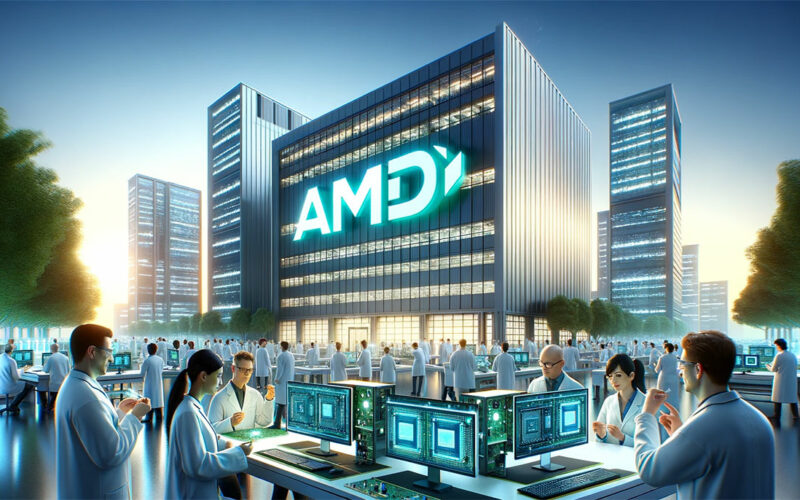AMD Statistics You Need To Know About The Company

In the pulsing heart of tech evolution, where silicon chips beat like drums, AMD statistics narrate an epic tale. Imagine numbers dancing, weaving the story of a titan’s stride through the global semiconductor arena.
This isn’t just about dry figures; it’s the pulse of innovation, a rhythm tapped out by Ryzen processors and Radeon graphics echoing in every gamer’s den and data center.
Dive deep with me. We’ll surf the wave of AMD’s financial growth, dissect CPU market shares, and unravel the threads of chipset production volumes.
It’s a journey through a landscape where Zen microarchitectures stand tall and NASDAQ: AMD scribbles fortunes in the stock market’s great ledger.
By the final punctuation mark, you’ll grasp the impact of Advanced Micro Devices on the tech ecosystem.
Anticipate clarity on GPU sales figures and revelations on how technology stock performance mirrors our collective digital cravings. These aren’t mere digits; they’re the digital age’s DNA, and we’re decoding it, one stat at a time.
Amd Statistics To Check Out
AMD Company Stats:
- AMD was founded in 1969.
- AMD’s headquarters are located in Santa Clara, California.
- AMD has over 13,000 employees worldwide.
- In 2022, AMD’s revenue was $16.67 billion.
- AMD’s net income in 2022 was $2.6 billion.
- AMD’s market capitalization as of November 20, 2023, was $196.52 billion.
- AMD is listed on the NASDAQ stock exchange under the ticker symbol AMD.
- AMD is a member of the S&P 500 index.
- AMD’s CEO is Dr. Lisa Su.
- AMD’s products are sold in over 50 countries.
- AMD has over 5,000 patents in the US.
- AMD has won numerous awards for its products, including the CES Innovation Award.
- AMD has partnerships with major technology companies, including Microsoft, Samsung, and HP.
- AMD has a strong commitment to sustainability and has set a goal to achieve net-zero carbon emissions by 2050.
AMD Product Stats:
- AMD’s Ryzen processors are designed for high-performance computing and gaming.
- AMD’s Ryzen processors have up to 16 cores and 32 threads.
- AMD’s Ryzen processors are built on the Zen architecture.
- AMD’s Radeon graphics cards are designed for gaming and professional applications.
- AMD’s Radeon graphics cards support ray tracing and variable rate shading.
- AMD’s Radeon graphics cards are built on the RDNA 2 architecture.
- AMD’s EPYC processors are designed for data center and enterprise applications.
- AMD’s EPYC processors have up to 64 cores and 128 threads.
- AMD’s EPYC processors are built on the Zen architecture.
- AMD’s Instinct accelerators are designed for AI and machine learning applications.
- AMD’s Instinct accelerators support mixed-precision and INT4/INT8 operations.
- AMD’s Instinct accelerators are built on the CDNA architecture.
- AMD’s Ryzen Threadripper processors are designed for high-end desktop computing.
- AMD’s Ryzen Threadripper processors have up to 64 cores and 128 threads.
- AMD’s Ryzen Threadripper processors are built on the Zen architecture.
- AMD’s Radeon Pro graphics cards are designed for professional applications, such as video editing and 3D rendering.
- AMD’s Radeon Pro graphics cards support hardware-accelerated encoding and decoding.
- AMD’s Radeon Pro graphics cards are built on the RDNA 2 architecture.
- AMD’s Ryzen Mobile processors are designed for laptops and ultrabooks.
- AMD’s Ryzen Mobile processors have up to 8 cores and 16 threads.
- AMD’s Ryzen Mobile processors are built on the Zen architecture.
- AMD’s Radeon RX 6000 series graphics cards are designed for gaming.
- AMD’s Radeon RX 6000 series graphics cards support hardware-accelerated ray tracing.
- AMD’s Radeon RX 6000 series graphics cards are built on the RDNA 2 architecture.
- AMD’s Ryzen Embedded processors are designed for embedded applications, such as digital signage and gaming machines.
- AMD’s Ryzen Embedded processors have up to 8 cores and 16 threads.
- AMD’s Ryzen Embedded processors are built on the Zen architecture.
- AMD’s Radeon Pro VII graphics card is designed for professional applications, such as video editing and 3D rendering.
- AMD’s Radeon Pro VII graphics card supports hardware-accelerated encoding and decoding.
- AMD’s Radeon Pro VII graphics card is built on the RDNA architecture.
- AMD’s Ryzen V1000 processors are designed for embedded applications, such as industrial control systems and medical imaging.
FAQ On AMD Statistics
How is AMD performing in the CPU marketshare?
Sure thing, the CPU battleground’s sizzling with AMD’s Zen architecture throwing punches. The market share stats show they’ve been chipping away at the competition, with Ryzen processors becoming a common sight in gaming rigs and workstations.
It’s an arm wrestle with Intel, and AMD’s grip is firming up.
What’s the deal with AMD’s revenue growth?
Well, it’s a bit like watching a rocket launch. AMD’s revenue growth has been skyward, thanks to their strategic partnerships and the demand for high-caliber data center equipment. The financial report paints a picture: AMD’s making some serious bank with their chips.
Are AMD GPUs keeping pace with the competition?
Imagine a photo finish in a high-octane race. AMD’s GPU sales figures reveal that their Radeon performance benchmarks are nudging closer to the competition. It’s a tight squeeze, especially in gaming where frame rates are king, but AMD’s keeping its cool.
What are AMD’s projections for future success?
Peering into the crystal ball, AMD is planting its flag with innovative chipset production volumes and enterprise server CPU market penetration. The projections? They’re gleaming with optimism.
AMD’s hedging bets on next-gen tech, and the trend lines in their corporate earnings data suggest sunshine ahead.
How does AMD’s stock performance compare?
Swipe through any tech company valuation charts, and you’ll see AMD’s ticker is doing more than just idling. Their NASDAQ: AMD metric has scribbled an encouraging narrative in the technology stock performance ledger.
It’s no roller coaster—think steady climbs with the occasional, heart-thumping drop.
What technological advancements are driving AMD forward?
Talking tech, it’s AMD’s high-performance computing stats that are getting the oohs and aahs.
The Zen kids—Ryzen, Threadripper—they’re the poster children for central processing unit advancements, while the Radeon units bring graphics processing unit innovations to the table. It’s a full house of trailblazing tech.
What market trends favor AMD?
Oh, the trend winds are blowing just right. With shifts towards remote work and cloud services, there’s a hunger for potent silicon.
AMD’s semiconductor global market share is inching up as they cook up high-performance computing delights and cloud infrastructure processors that are hot, hot, hot!
In what sectors is AMD most dominant?
Got to admit, AMD’s got its tentacles in a few pies. The gaming hardware statistics are juicy—gamers adore their GPUs. But don’t look away from professional and server markets, either. There, AMD’s EPYC servers and Ryzen Pro CPUs are making waves, getting nods from the enterprise crowd.
What’s the latest on AMD’s chip production?
The latest dish? AMD’s been buddying up with semiconductor foundries like TSMC, and they’re punching out chipsets faster than a cat on a hot tin roof. With sleek processors and AI chipsets, they’re on the production fast lane, trying to kiss goodbye to those pesky supply hiccups.
How does AMD innovate in the GPU space?
Let’s break it down. AMD is all about that RDNA architecture, which is like their secret sauce for GPUs. The Navi series? That’s where the magic’s at, with frame rates and resolutions that get gamers grinning. They’re pushing boundaries, making pixels work overtime, and slaying shadows with ray tracing.
Conclusion
As digits and graphs waltz to a close, here’s the skinny on AMD statistics: they aren’t just cold numbers, they’re the groove of a giant’s dance. We’ve jogged through revenue charts, high-kicked over processor benchmarks, and even did the twist with market share trends.
- Ryzen processors? Check.
- GPU showdowns? Done.
- A peep into Silicon Valley’s playbook? Absolutely.
These stats are more than just figures in a spreadsheet; they’re tales of tenacity, a snapshot of a heavyweight in the silicon coliseum. We’ve talked shop about technology stock performance and pulled back the curtain on CPU advancements.
As the lights dim on our stat-so-wonderful soirée, let me leave you with this: AMD’s narrative is etched in each stat, woven in the very fabric of our tech tapestry. Keep a keen eye—it’s sure to be a splendid spectacle as the numbers roll out in their next act.
If you liked this article about AMD statistics, you should check out this article about Adobe statistics.
There are also similar articles discussing Alibaba statistics, Amazon statistics, Apple statistics, and Cisco statistics.
And let’s not forget about articles on Facebook statistics, IBM statistics, Intel statistics, and Microsoft statistics.
- What Is Rust Used For? A Guide to Its Applications - May 4, 2024
- Simplifying Video Editing: Creative Apps Like Kapwing - May 3, 2024
- Healthcare software: Exploring 10 essential types and their benefits - May 3, 2024








